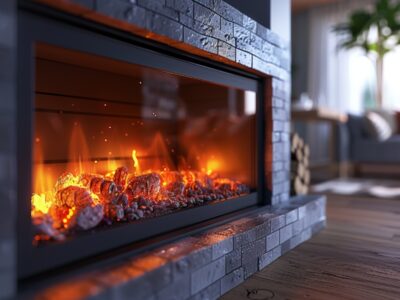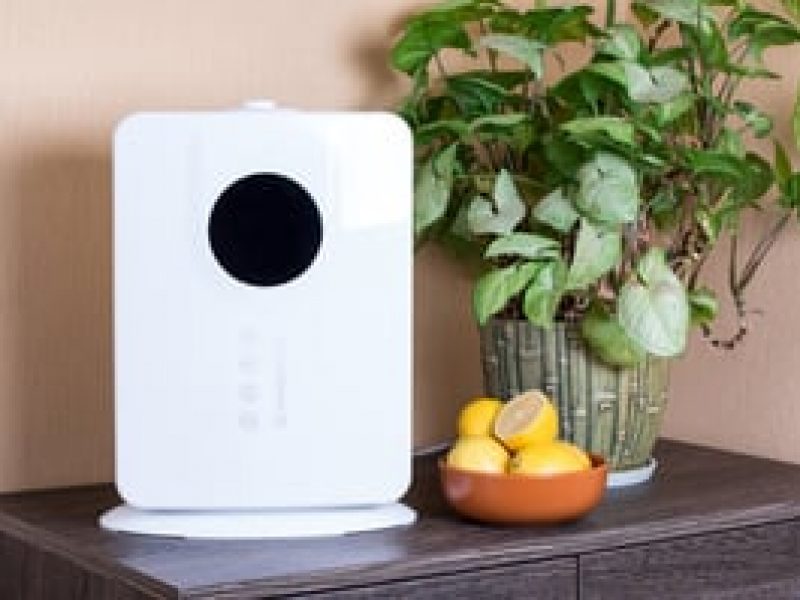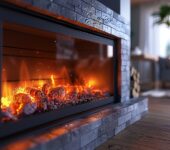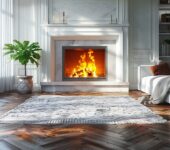Table of Contents
There’s nothing better than a warm fire on a cold winter night. However, this enjoyable winter pastime may serve up a few side effects you weren’t expecting, such as reduced indoor air quality.
The good news is that you can improve indoor air quality while enjoying your fireplace.
Keep reading to learn about your fireplace, its impact on air quality, and steps you can take to improve your indoor air quality.
Dangerous Pollutants Produced by Fireplaces
It’s important to note that it is not just a wood fireplace that is guilty of producing indoor air pollutants that can affect your indoor air quality. Some of the pollutants you should be aware of include:
Particles
When it comes to fireplace safety, you must consider the impact that wood smoke can have on your health. The particles in the smoke can cause damage to your lungs.
Over time, it can cause issues with breathing and aggravate other conditions, such as bronchitis and asthma.
Carbon Monoxide (CO)
Often, carbon monoxide poisoning is confused and thought to be food poisoning or the flu. That’s because CO gas impacts your body’s ability to use oxygen. Exposure to CO will cause headaches, weakness, dizziness, fatigue, nausea, and confusion, which can eventually lead to death.
You can install oxygen depletion sensors and carbon monoxide detectors to ensure your safety.
Nitrogen Dioxide (NO2)
This is known as a throat, nose, and eye irritant. It can cause shortness of breath if there are high concentrations of it.
If you have a strong sense of smell, you may notice high levels of NO2.
Different Types of Fireplaces Present Different Dangers
Regarding fireplace air quality, it’s important to note that not all fireplaces are the same, nor do they produce the same dangers.
For example, while all fireplaces can release harmful emissions, wood-burning units are considered the most dangerous in this aspect.
It is reported that wood-burning fireplaces are a significant source of air pollution. One way to combat this is by venting the fireplace properly. Unfortunately, if you have a ventless unit, it increases pollutant levels inside your home.
If your home has a tight seal, you may also experience an increased buildup of air pollution. This includes dangerous particles, gases, and water vapor that can cause mildew or mold growth.
Taking Steps to Reduce Air Pollution from Your Fireplace
While fireplaces produce air pollution, there are several things you can do to help reduce the pollutants inside your home. These things include:
Use an Air Purifier
While you can use a smaller room air purifier to help eliminate pollutants, the best option is a whole-house HEPA air filtration system.
Adding this to your cooling or heating system will help control smoke pollution. Most of these devices can remove most air particles that are at least 0.3 microns.
Use the Right Fuel
You can create a cleaner, hotter fire by using seasoned wood in your wood-burning fireplace. This is usually made of hardwoods, like beech, oak, ash, or maple.
You should avoid burning treated, painted, or wet wood in your home fireplace.
Invest in Regular Maintenance
Make sure to clean and inspect your fireplace and the venting system regularly to protect the air quality in your home.
If the chimney flues are cracked, leaking, blocked, or dirty, it means that air pollution is coming into your home at high levels. Incorrectly maintained and improperly installed components can cause this to happen, too.
Along with cleaning the unit yourself, you should invest in an annual inspection by a professional to find any issues you may be unaware of.
Heat More Efficiently
If you have an older stove or fireplace in your home, now is the time to consider replacing it with a newer, modern option.
You can find units designed to use less wood, which will save money and reduce indoor air pollutants.
Make sure a reputable company handles the installation of the fireplace you choose. This will ensure that it operates as efficiently and effectively as possible.
Change Your Burn Practices
Avoid burning charcoal, trash, solvents, garbage, paints, petroleum products, or rubber in your fireplace. Not only will burning items like this be hazardous to your health, but it can also impact everyone in your house and your neighbors.
Instead, use smaller pieces of wood and make sure you never overload your fireplace.
Clean the ashes out regularly since excessive ash can clog the intake vent and reduce its efficiency. Make sure you dispose of the ashes safely to prevent a fire.
Keep an eye on what’s coming out of your chimney, too. Fires that burn properly and safely will produce a wisp of white steam. If the smoke appears thicker or darker, it means more pollutants are in it.
If you know your indoor air quality is poor, you should avoid burning wood.
Improve Indoor Air Quality with These Fireplace Tips
If you want to improve indoor air quality in your home while enjoying your fireplace, use the tips mentioned above.
These tips will help you reduce the pollutants released in the air and ensure no dangerous pollutants are accumulating in your living area.
Remember, it’s wise to invest in regular maintenance at least once a year. If you can’t handle this yourself, call the professionals for assistance. Calling for this right before you plan to use your fireplace in winter is smart.
If you are ready to have a fireplace installed and want to find out about the best option for your home, contact us for help and information. We will ensure you get the quality and safe fireplace you want for your home.
Latest Articles

Fireplace Safety Screen Vs. Safety Glass
Table of Contents1 What Is A Fireplace Safety Screen?2 What Is Safety Glass?3 What Are The Differences Between A Fireplace Safety Screen And Safety Glass?4

How Much Does It Cost To Convert Two Garage Doors To One?
Table of Contents1 What Is Garage Door Conversion?2 Why Would Someone Want to Convert Two Garage Doors to One?3 What Are The Factors That Affect

Garage Door Glass Inserts: Customize Your Garage Door Appearance
Table of Contents1 What Are Garage Door Glass Inserts?2 What Are the Benefits of Garage Door Glass Inserts?3 What Types of Glass Inserts Are Available?4





















































































